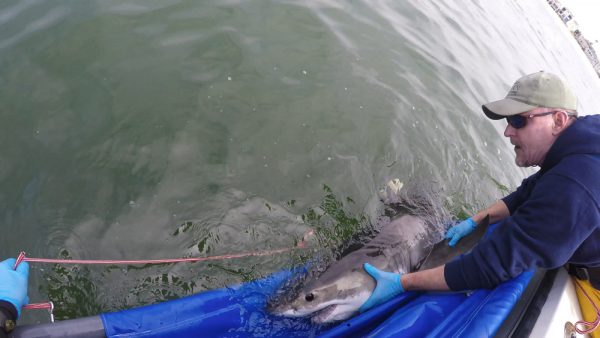By Jean Ardell, Special to the Independent
Since Leeanne Erickson was attacked two months ago by a great white shark at San Onofre State Beach, great whites have been spotted by authorities five times between the state beach and Dana Point in recent weeks. Most recently, a fisherman reeled in a great white shark at San Clemente Pier on May 22. Several other sharks were spotted nearby.
The rapid fire reports raise questions among surfers, paddle boarders, divers, swimmers, lifeguards, and the scientists who study these kings of the sea: have the habits of the great whites changed? If so, why? And how are the ocean lovers along the coast to adapt?

Jeremy Frimond, marine protection officer for the City of Laguna Beach, noted, “Great white shark sightings are not as new an occurrence as some might think. Pockets of juvenile great whites have been sighted along the Southern California coastline for the past decade.” Last year, the department acquired a drone to deploy when responding to a report of a shark sighting, Frimond said.
He could not confirm the sighting of a great white in Laguna’s waters, but one was evident in a Facebook drone photo over Crescent Bay, credited to photographer Connor Morris.
“The ocean is a large, wild frontier with inherent dangers,” said Frimond, noting that statistically speaking, greater risks stem from a lack of knowledge of surf conditions and rip currents.
Great white sharks have always been around, recalls Dale Ghere, a Laguna Beach resident since 1960. “When I used to dive, I’d see them.” But Ghere, who worked as a city lifeguard from 1960 to 1974, remembers no instance of a shark biting a human. “I’ve seen spear fishermen and divers dragging in lines of caught fish. Certainly a shark would’ve come after them,” he says, “and didn’t. So why now?”
Dr. Chris Lowe, professor of marine biology and director of the Shark Lab, at California State University, Long Beach, for the last 19 years, has been fielding lots of these questions recently. Lowe cites several reasons for the changes in shark behavior, much of it instigated by humans.
In 1994, a voter-approved gill net ban went into effect, prohibiting the use of gill and trammel nets, which tended to capture very young sharks. “Sexual maturity is reached at 12 years, so all those protected babies grew up to reproduce,” Lowe said in a telephone interview.
It also helped that the sharks’ preferred prey, seals and sea lions, have been increasing in population since the enactment of the federal 1972 Marine Mammal Protection Act. That spawned a “tremendous recovery” of the adult sharks’ primary food source, said Lowe, who with his students over the last 10 years, has been studying the baby and juvenile great whites of Southern California. He said newborn sharks fend for themselves and feel safer close to shore, where prey such as sting rays are easy to hunt. The rise in ocean temperature is another contributing factor, he said. “The water is warmer, and the babies are just too small to retain their body heat. Should the ocean fall below 60 degrees, they will migrate south to Baja,” explained Lowe. “So Southern California is a nursery and our beaches are really the cradle for the young great whites.”
Lowe believes that the recent sightings have likely been teenage white sharks, a part of the life cycle scientists know the least about. There seem to be teen “hot spots,” where juveniles tend to congregate, such as Santa Monica Bay, Huntington Beach, Ventura, and San Onofre. Much like their human counterparts, the teenage sharks hang out for a period of time in one locale before moving on to another favored place.
During a talk to the American Cetacean Society of Orange County on May 25, Lowe expanded on how he and his student Shark Lab team rely on a sophisticated (and expensive) array of acoustic and satellite telemetry to tag and track the great whites, among other species. “We’re also developing surveillance underwater robots to help us understand why certain beaches are so appealing to great white sharks.”
Lowe cited the use of drones to spot and size sharks near shore as invaluable to lifeguards in determining when the waters become unsafe for humans.
He pointed out that for much of the 20th century overfishing of great white sharks along with a declining food supply and poor water quality had caused the population to dwindle. He credits the regulatory acts and regulations since the 1970s for reversing that.
“The recovery of the great white shark is an environmental success story. We had 50 years of ocean swimming without predators. Now we have to reeducate people about the change.”
Getting Along With the Great Whites
Here’s the lowdown on swimming with sharks from Chris Lowe, director of the CSU Long Beach Shark Lab.
Baby whites measure about six feet in length, and increase in size about a foot a year for several years before leveling off. So even a newborn is bigger than most humans. Most surfer-shark encounters result in the shark just cruising on by. However, should a great white move in fast before veering off, that’s a warning sign. “Keep your arms and legs up out of the water,” he said. “Bumping is bad.” If a shark makes contact with a board, it’s time to get out of the water.
As to why a shark attacks, it could be either a “curious bite or a predatory ambush. We just don’t know,” Lowe said.
Lowe’s theory is that the great white sharks’ new behavior patterns will continue and that they will remain in the area into the summer. Meanwhile city lifeguards recommend swimmers stay in proximity to a open lifeguard tower.
More info on sharks is on the city’s website.





[…] Lab at Cal-State University, Long Beach. The natural balance is back, evidence that the ocean is healthier, he said. “We need to learn to live with […]